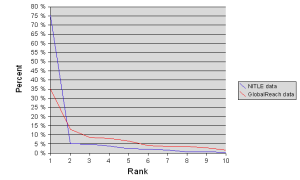iMovies anyone?
I recently learned about Podzilla — a Linux distro for the iPod. iPod already has some recording support, but here’s the kicker — you can pay the $50 for the iPod recording hardware and get 16-bit recordings at 8kHz (telephone-ish quality) or you can install Podzilla for free and record whatever you want at up to 96kHz (DVD audio quality).
Why is recording crippled on the iPod? Well, part of the answer is that the market for voice recording hardware is pretty small. Dedicated voice recorders are incredibly expensive, and Apple is not at all in that market. They’re out to sell their iPods and get people to use iTunes. Furthermore, voice recording doesn’t need amazing quality, so the low audio rate is sufficient for most.
However, this is not a market issue. If Apple really wanted to make an iPod capable of high quality recording, they could have. Their competitors, such as Creative, Archos, and iRiver, have MP3 players full quality MP3 and WAV recording (44kHz, CD quality). My Creative Jukebox 3 even has digital recording inputs. In fact if Apple was concerned about being competitive, they would have included high quality recording in the iPods from the very beginning.
Which leads me to an interesting conclusion: Apple was pressured by the RIAA and big music distributors to disallow high quality recording on iPods. If you’re the RIAA, you’re worried that someone can take a CD, plug it’s output right into an iPod, then play the CD and end up with MP3s on the iPod (or AACs or whatever their damned format is). Worse yet, someone can bring an iPod to a concert with some microphones and make great quality bootlegs (because bands haven’t learned that if they could make live concert CDs on the spot, they could rake in the money).
I think Apple was either told by the RIAA no recording on the iPod or intentionally crippled it to avoid the wrath of the music industry in the first place. Think about the case if Apple had allowed high quality recording… “Sorry big music distributors, but we released our tiny music player with the ability to record the same music of yours that we sell online. We know people will record music themselves and avoid paying you the royalties you so desperately want. But we don’t really need the iTunes store to sell iPods because we’re Apple and people will buy our hardware since it looks cool, is vastly overpriced, and has less features than our competitors.” Or something like that.
All of this makes me wonder about the iPod photo, or whatever that new device is. Already most of Apple’s competition has moved on to portable movie players, some of which even record video, so why is Apple just moving to photos and not movies? My prediction is that Apple will have a movie playing iPod just as soon as they create iMovies (or iFilms or something like that, like iTunes but for movies… call it Quicktime?) and sort out the issues with the MPAA and big movie distributors.
To put this another way, if Apple doesn’t get into movies, then it’s because they couldn’t line up the studios. I think most people are comfortable making MP3s from their CDs now, but Apple would have to overcome a huge hurdle to get DVD ripping software on everyone’s computer. Why would you buy iTunes if you already own the CD? Likewise, why would you want to buy videos online when you already own the DVDs? The MPAA has harshly attacked anyone releasing DVD ripping software, so Apple would have to get their blessing before the iPod + video or iMovies comes out.
But that’s just my opinion. Back in reality, I don’t know of any other portable music player manufacturers that also have a vested interest in selling online music except for Sony, but then Sony has been very quiet about their efforts, and they own the music they’re selling anyway. Since Steve Jobs is already in bed with the movie studios (Pixar) and since iTunes has been more successful than anyone could have predicted, I’m sure he’ll be able to convince the other big movie studios to fall in line with the portable revolution. The iTunes store is as important to iPod’s success as the iPod itself — both for the RIAA’s blessing and the iPod’s overall success — so a movie version of iTunes would be equally essential for Apple to break into the handheld movie player market.
I’m certain this isn’t the only instance of the RIAA and others putting pressure on big software companies to bow to their whims. Microsoft wholeheartedly jumped onto the DRM bandwagon, much to the delight of the media industry, with recent versions of their Windows media formats. I just wonder if MS did that before or after their conversations with those companies. I wouldn’t characterize these as “alliances” as much as “necessities for doing business.” If MS hadn’t bowed to the pressure of the RIAA and others, then someone else would have. Therefore, I say MS and Apple both made the right decision for their business, much to the detriment of all the people stuck with their hardware and sofware. Pressure like this goes beyond software and hardware, but I’ll deal with those aspects some other time.
I’ll give you one other similar example. There’s a Palm device — the Treo 650 — that was made specifically for Sprint and is pretty much a combo cell phone and PDA. The 650 came crippled in that you couldn’t use its Bluetooth to connect to the Internet. Why would Sprint let you do that anyway? Someone hacked it and enabled that feature; supposedly it was always there but just hidden. That same person also figured out that you can use an SD WiFi adapter with some driver hacks — a wifi adapter that Palm wouldn’t release drivers for. Sprint certainly pressured Palm just like the RIAA pressured Apple; both Sprint and Palm want to milk the cell phone market for everything they can.
Back to Apple… Based on what Apple did before, I bet their iPod photo already has video support. It’s just crippled. And so if you’re patient enough, wait for a version of Podzilla to uncripple the video playback support built into their new iPod. It’s either that, or wait until a sanctioned, overpriced, under-featured iPod video finally comes out. Or just pick up one of the non-Apple portable media players that already support video playback and avoid the whole iPod thing in the first place.



